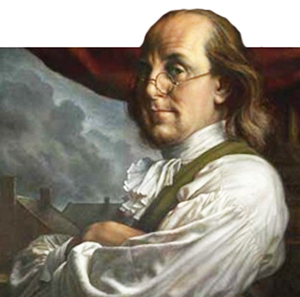
OPTIMISM: Ben Franklin and the 200-Year Endowments

Franklin’s optimism was so irrepressible that he left 200-year endowments to Boston and Philadelphia.
In 1785 a French mathematician named Charles Joseph Mathon de la Cour wrote a parody of Benjamin Franklin’s Poor Richard’s Almanac in which he mocked the unbearable spirit of American optimism represented by Franklin. The Frenchman fictionalized about “Fortunate Richard” leaving a small sum of money in his will to be used only after it had collected interest for 500 years.
Franklin, who was seventy-nine years old at the time, wrote back to de la Cour, thanking him for the great idea and telling him that he had decided to leave a bequest to his native Boston and his adopted Philadelphia of 1,000 pounds to each, on the condition that it be placed in a fund that would gather interest and support the public good for the succeeding 200 years.
De la Cour wrote a parody of Benjamin Franklin’s Poor Richard’s Almanac in which he mocked the unbearable spirit of American optimism represented by Franklin.
Franklin’s optimism was not an easy optimism to embrace. Since no nation in the modern world had ever attempted what the American colonies had set out to do, it was appropriately called the “American Experiment.” The future of the new nation was tenuous at best, and no one knew that better than Franklin. Walking out of the Constitutional Convention in 1787, Benjamin Franklin was asked, “What kind of government did you give us?” Franklin replied, “A republic if you can keep it.”
Notwithstanding the perils that lay ahead, Franklin’s irrepressible optimism enable him to see past the innumerable needs of the moment and uncertainty of the future. Two years later in 1789 he wrote a codicil to his will that provided funds to establish the 200-year endowment.
SEEDS OF OPTIMISM
People with a fearful, pessimistic view of the future are never going to fund multigenerational or perpetual endowments. Neither will those who think the world is destined to get worse and worse. They may be the kindest and most generous souls on earth, but they are not endowment makers. For social, political, and/or religious reasons, it fundamentally goes against the way they see the world.
They may be the kindest and most generous souls on earth, but they are not endowment makers.
Great institutions are built by visionaries — optimistic leaders and supporters who are certainly aware of the ills and evils of society but choose to focus their attention on the preferred future. They look ahead, visualize what could be done and employ their resources accordingly. Those are the kind of forward-thinking optimists that endeavor to secure and stabilize the future through endowments. Those are the donor relationships we want to cultivate.
Conversely, fundraisers who regularly play the crisis card to motive their donors to give are in effect diminishing the possibility of a gift to the endowment. They plant a pessimistic seed in the donor’s mind suggesting that the organization will not survive.
They plant a pessimistic seed in the donor’s mind suggesting that the organization will not survive.
Benjamin Franklin’s will and codicil are extraordinary documents in the history of endowments. Franklin did not invent the endowment, but true to form, the clever and irrepressibly creative Franklin could not resist tinkering with an idea in order to improve it. In the 1789 codicil to his will, he donated 1,000 pounds to the inhabitants of his native Boston and another 1,000 pounds to his adopted Philadelphia. The condition of the gift to each city was that it be placed in a fund that would gather interest and serve a designated purpose for a period of 200 years.
The purpose of his gift, as with many such gifts, related to his own experience. The young Franklin received his professional training as a printer’s apprentice and got his start in business with a loan from two friends. In the codicil he noted, “(That loan) was the foundation of my fortune and all the utility in life that may be ascribed to me.” So then, it is not surprising that the purpose of his endowment was to help young apprentices.
His instructions were laid out with the following words:
“The Trustees shall…let out the sum upon interest, at five percent, per annum, to such young married artificers, under the age of twenty-five years, as have served an apprenticeship in the said town, and faithfully fulfilled the duties required in their indentures, so as to obtain a good moral character form at least two respectable citizens, who are willing to become their sureties, in a bonk with the applicants, for the repayment of the moneys so lent, with interest, according to the terms hereinafter prescribed…”
WHAT ACTUALLY HAPPENED
In 1894, at the end of the first 100 years, the Boston fund had been used as instructed and had grown to 131,000 pounds ($391,000). In the following century the bulk of the proceeds were used to fund public works in Boston. In 1905, $322,490 was used to establish the Franklin Union, a technical school. The remainder of the funds continued to be loaned out for apprentice programs and scholarships. In 1990, the end of the second century, Franklin’s Boston endowment was worth more than $5,000,000 and the Philadelphia fund about half that. In both cities Franklin’s endowment has been used to help thousands of young people and has served as an enduring testament to philanthropy and community service.

Franklin Legacy Prize Medal
In May 2005, a group of exceptionally creative young people selected from all over the nation gathered at the Smithsonian Institute in Washington D.C. for an award ceremony. They were the latest recipients of the Franklin Legacy Prize medals. Franklin’s 1789 codicil made provisions for awards to be given annually to outstanding young students, providing silver medals that have been awarded each year since 1793.
Eddie Thompson Ed.D. and Walt Walker






Help for mathematics
Wish of benjamin franklin is so much praiseworthy.